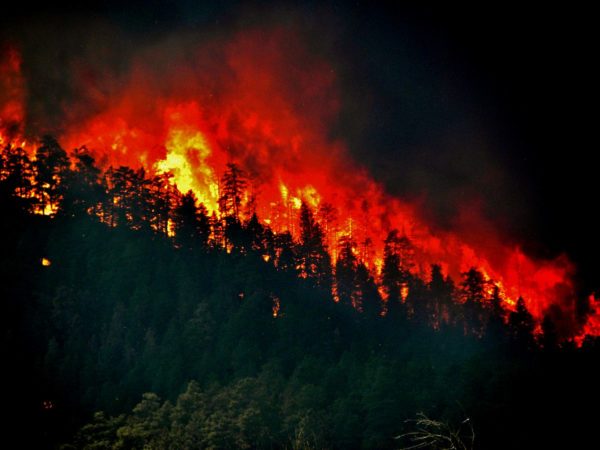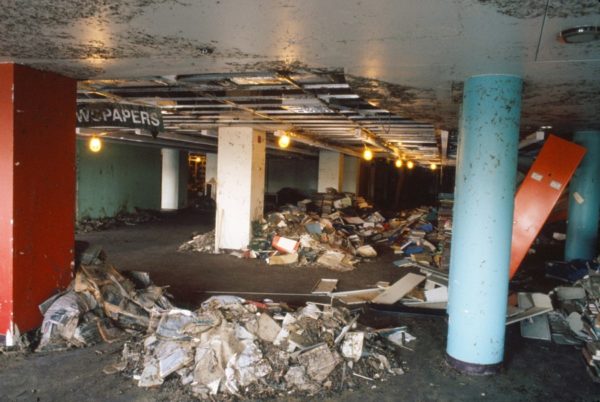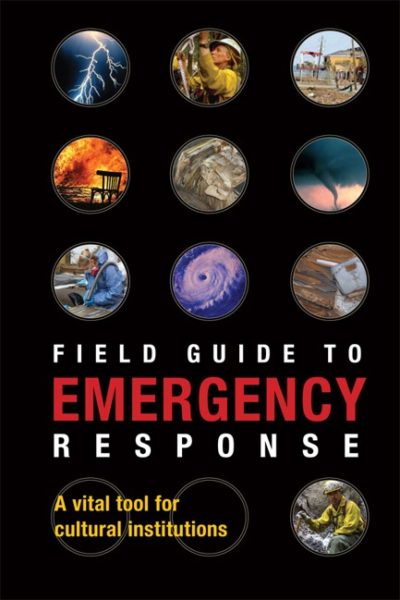
Right now, as we focus on library closures and service reductions due to the global pandemic, it’s important to remember to prepare for other disasters, as fire and flood season will soon be upon us. Now is a great time to create a disaster plan for your library, or do a little spring cleaning and refresh the plan you have.
Why Plan?
You’ve probably noticed that in the last couple of decades, natural disasters have escalated in frequency and intensity. Whether it’s hurricanes on the coasts or wildfires in the forests, disasters are affecting more people and causing more damage than ever before. Not only do we have more disasters, but we have more of what are called cascading disasters – one disaster caused by another, for example, a landslide that occurs after a wildfire. There are several reasons for this, including climate change as well as human population growth and expansion into previously unpopulated areas. But it’s not just natural disasters your library should plan for. In 2009, Colorado Connecting to Collections conducted a survey that found that 41% of Colorado’s cultural heritage institutions had experienced some sort of disaster that damaged their collections. Of these, 80% were attributable to water leakage. Other events that can affect your library include vandalism, building and structural problems or construction, pest outbreaks, and cyber attacks.

There are many reasons to create a disaster plan. One of them is stewardship. Cultural and historical collections are entrusted to our care by our communities, so we have an obligation to do whatever we can to protect them. Obviously, life and safety are the highest priorities. But if we possibly can, we should do whatever possible to protect our cultural and historic resources. There’s also the fact that having a written disaster plan will greatly aid in communications and will reduce chaos. And plans don’t need to just be for big disasters, but should address smaller emergencies, as well.
Helpful Resources for Writing a Disaster Plan
Putting together a disaster plan may sound daunting, but it doesn’t have to be. Luckily there are some great resources and templates available that can guide you through the steps of creating a library disaster plan. Don’t forget that you should also have a disaster plan, as well as backup measures, for your digital collections. Here are some recommended resources and templates to help get you started:
- American Library Association’s Library Disaster Planning and Response website provides links to a wide variety of planning tools and resources for library preparedness and response.
- The Library of Congress also has helpful information on their website.
- Northeast Document Conservation Center (NEDCC)’s dPlan is a free, online disaster planning tool. Register as a new user and then fill in the data fields to create your plan. NEDCC also has many additional disaster assistance resources and links on their website.
- For a lower-tech option, California Preservation offers a very thorough, printable PDF Library Disaster Plan template.
 The Pocket Response Plan (PReP), developed by the Council of State Archivists, is a quick summary of your plan and list of contact information that can be printed on legal size paper and folded to fit in a wallet or pocket. If you prefer having this information entered in your mobile device, PReP can also serve as a helpful guide for what to include.
The Pocket Response Plan (PReP), developed by the Council of State Archivists, is a quick summary of your plan and list of contact information that can be printed on legal size paper and folded to fit in a wallet or pocket. If you prefer having this information entered in your mobile device, PReP can also serve as a helpful guide for what to include.- The Foundation for Advancement in Conservation (FAIC)’s Field Guide to Emergency Response: A Vital Tool for Cultural Institutions is a handy guide to keep on your desk. It includes step-by-step instructions for responding to a disaster, including who to call, how to prevent further damage, and how to ensure the safety of your staff. Copies can be purchased from FAIC for $25.
- The Getty Conservation Institute’s Building an Emergency Plan: A Guide for Museums and Other Cultural Institutions is another helpful guide.
- Lyrasis has put together a helpful Digital Preservation Toolbox on their website.
 Also as part of your plan, you should stock an emergency supply cabinet with cleaning supplies; products for blotting and drying wet books; personal protective equipment; and more. Also be sure to include flashlights (the power will probably be out) and a digital camera (FEMA and insurance companies require documentation of disasters). The Conservation Center for Art and Historic Artifacts (CCAHA) has a handy supply checklist on their website.
Also as part of your plan, you should stock an emergency supply cabinet with cleaning supplies; products for blotting and drying wet books; personal protective equipment; and more. Also be sure to include flashlights (the power will probably be out) and a digital camera (FEMA and insurance companies require documentation of disasters). The Conservation Center for Art and Historic Artifacts (CCAHA) has a handy supply checklist on their website.
Working Together as a Community
When planning for disaster, it’s also a good idea to get to know your local first responders. Follow them on social media, and invite them for a tour of your library. Give them a copy of your floorplan, and highlight the areas that are of most concern in an emergency, such as your special collections. It’s also helpful to schedule CPR classes and fire extinguisher instruction. The Connecting to Collections survey found that 95% of institutions had fire extinguishers, but only 36% had trained their staff on how to use them!
Since libraries are already community resources providing information and gathering space, they should continue to offer these services if at all possible following a fire, flood, tornado, or other large disaster. Residents may have lost internet service at their homes, so the library can provide this service. You can also have representatives from the Federal Emergency Management Agency (FEMA) or insurance companies stationed at the library to help answer questions. Have your children’s area available, too, to provide a place for kids to hang out while their parents are gathering information and using the computers; it’ll also provide distraction for youngsters during traumatic times. In addition, you’ll also want to post frequent updates on social media. Finally, in large-scale community natural disasters, patrons will often seek the library’s advice on how to preserve their own family heirlooms and collections. The Heritage Emergency National Task Force (HENTF) – a partnership between FEMA and the Smithsonian – provides helpful “Saving Family Treasures” fact sheets that you can post or distribute to patrons.
Need Help?
If a disaster occurs, your library doesn’t need to face it alone. The Colorado Cultural and Historic Resources (CHR) Task Force is a statewide network of professionals from libraries, museums, archives, historic sites, and other cultural resources who have come together to work with the Colorado emergency management community to further the interests of cultural and historic resources in disasters. I’ve been a member of the CHR Steering Committee since 2012. We are a resource that any library or other cultural institution in Colorado can turn to if they need assistance before, during, or after a disaster. We can help with evacuation of collections under threat of flood or fire; assist with disaster planning and education; and connect you with conservators or other experts. We also participate in the State Emergency Operations Center so we can be a resource in communicating the needs of cultural heritage organizations to emergency management. For more information, visit our website at chrtaskforce.com [link broken as of Aug. 8 2021] or join our listserv at http://cvl-lists.org/mailman/listinfo/chr_cvl-lists.org.
There are also several national organizations that can assist cultural institutions experiencing a disaster. CCAHA a 24-hour collections emergency helpline; information can be found on their website. Also, FAIC offers a “National Heritage Responders” program.
Finally, if you’re looking for information on COVID-19 and library collections, our friends in Massachusetts have prepared this helpful list of resources regarding libraries and public health emergencies.
If you’d like more information, contact me at zimmer_a@cde.state.co.us or tune in to a free CSL in Session webinar, Disaster Planning and Assistance for Libraries, on Thursday, March 26 at noon MTN.
- How to Spot the Differences Between Eagles and Hawks - August 16, 2021
- How Transportation Projects Help Tell the Story of Colorado’s Past - August 9, 2021
- Time Machine Tuesday: The Night the Castlewood Canyon Dam Gave Way - August 3, 2021